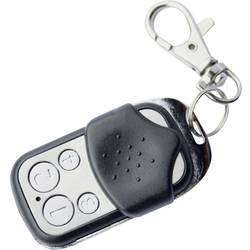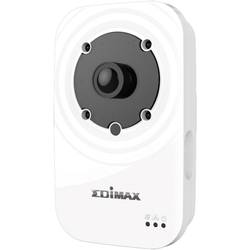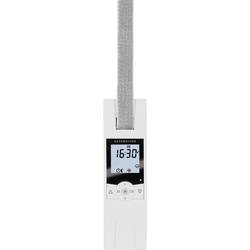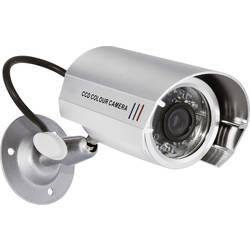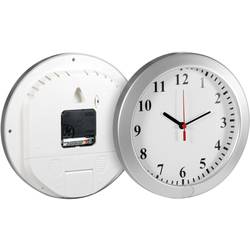€42.82
Priemerné hodnotenie:0/5(0x)
Vlastnosti a parametre výrobku
Skúsenosti užívateľov
Otázky a odpovede
Dokumentácia
Popis
Vlastnosti a parametre výrobku
| Séria (domáca technika) | Schwaiger HOME4YOU |
|---|---|
| Bezdrôtové zariadenie (Smart Home) | Z-Wave Z-Wave+ |
| Miesto použitia | Do interiéru |
| Napájanie | Na batérie |
| Frekvencia | 868 MHz |
| Max. dosah | 20 m |
| Farba | Čierna |
| Vonkajšia šírka | 30 mm |
| Vonkajšia výška | 56 mm |
| Rozmer, hĺbka | 10 mm |
| Kategória výrobku | Diaľkové ovládanie |
| Tok signálu (konektor A na B) | Obojsmerný (bi) |
Skúsenosti a názory zákazníkov
- Skúsenosti užívateľov nie sú k dispozícii.
Otázky užívateľov
- Užívatelia k tomuto výrobku zatiaľ nemali žiadne otázky.
Dokumentácia
Podmienky používania dokumentácie
Direct activation of preconfigured scenes Devices in the association groups previously receive „scene controller configuration“ defined commands obtained through the Z-Wave command. This feature expands mode 1 and 2, but requires corresponding predefined scenes. In this mode the device follows communication pattern 6.
Generic scene control commands to an IP gateway (This mode is intended for experts). In this configuration, the buttons of the key fob can trigger certain events in a gateway. These events are determined by an event number, which is always two digits in this key fob. The upper decimal place is determined by the button number and the decimal point below the event number by the action taken.
The following actions are possible: 1 = on 4 = stop dimming upwards 2 = off 5 = start dimming downwards 3 = start dimming upwards 6 = stop dimming downwards Example: Pressing button 1 sends an event with number 11 (button 1 + ON), and when you release an event with number 12 (button 1 plus OFF).
In management mode the four buttons have individual meanings: Button 1: Inclusion/exclusion. With this function, the key fob can be included in the Z-Wave from any po -sition in the network, as long as there is wireless contact with only one device in the network. The primary controller and all the devices that form a wireless connection between the fob and the primary controller must support Explorer Frames. If you don‘t feel sure about it, avoid this function and include the device using button 3.
Button 2: Sends a node information frame and a wake up notification. Details of these functions can be found in the relevant sections of this manual.
Button 3: Resets the device, see explanation in the Installation section Button 4: Association mode. With this button actuators can be added directly to the corresponding associ -ation groups of the key fob. Details can be found in the manual section on associations.
Communication with a battery-powered deviceThe device is battery-powered and to save power it is thus usually in deep sleep mode. In deep sleep mode the device cannot receive any wireless signals. Therefore a (static) controller is required, which is mains powered and therefore always available for wireless data transmission. This controller – for example an IP
gateway – manages a message mailbox for this battery-powered device, in which messages to the device can be temporarily stored. Without such a static controller using this battery-operated device will quickly discharge the battery or render use completely impossible.
This device regularly wakes up, reports this by sending so-called wake up notifications and then empties its mailbox in the static controller. If the inclusion is carried out by means of a static controller such as an IP
gateway, this controller will automatically perform this configuration and usually offer a user interface, to adapt the wake up interval to user needs. The wake up interval is a compromise between maximum battery life and minimum response time of the battery-powered device.
Immediately after the inclusion the device remains awake for about 10 seconds, so that a controller can perform configuration tasks. The device can then always be woken manually. For this, the management mode is activated (keep all four buttons pressed for 5 seconds) and then press button 2.
The device has a wake up interval that is typically automatically configured by a controller. However, the configuration parameter 25 blocks the wake up, regardless of whether a wake up interval has been configured. It should protect the battery in case of unwanted configuration of a wake up interval against unnecessary energy losses. If the device ID 0 is selected as the target device for the wake up notification, the periodic wake-up is also suppressed.
It is possible to specify the device number 255 as the destination device for the wake up notification. In this case the message is sent as a broadcast to all devices with direct wireless connection. The advantage of immediate notification is offset by the disadvantage that, where appropriate, the device consumes more time in active mode and thus more battery capacity.
Meaning of LED signals1. Positive confirmation – green 2 seconds 2. Error – red 1 second 3. Confirmation of a button – green 1/4 second 4. Waiting for association group dial or network management – flashing green 5. Waiting for NIF in association mode – Flashing green and red Product descriptionWith the Schwaiger ZHF01 Z-Wave devices can be controlled directly and different scenes can be activated in an IP gateway as well. Although the ZHF01 controls devices directly, it cannot manage networks as a Z-Wave controller but always requires an additional controller for inclusion and exclusion. The ZHF01 can operate in five different modes of operation that are mixed with one another and determined by configu -ration parameters.
1. Direct control devices associated with single button operation (Devices in Association Group 1 are controlled by pressing button 1, Group 2 with button 2, etc. Single click = ON, Double = OFF, hold = dimming up, click and hold = dimming down) 2. Direct control devices associated with double button operation (Devices in Association Group 1 are controlled by the pair of buttons 1 and 3, devices in Association Group 2 by the button pair 2 and 4. Click on larger button = ON, clicking on smaller button = OFF, clicking and holding the larger button = dimming out, click and hold the smaller button = dimming down) 3. Scene activation in an IP gateway (Clicking a button activates the corresponding scene in the IP gateway) 4. Direct activation of preconfigured scenes in equipment (Devices in association groups receive previously defined commands. This feature expands mode 1 and 2, but requires switching actuators with respective scene ability) 5. Control of devices in the immediate proximity (the device located in the respective immediate vicinity is always controlled) BatteriesThis device is operated with batteries. Only use batteries of the specified type. Used batteries contain hazardous substances and must not be disposed of with household waste! 1 x CR2032
To replace the batteries, the battery case can be opened by loosening the three Phillips screws on the back.
By using a small screwdriver or other pointed object the battery can be pushed out of position. When re-closing the battery case. Make sure that the white distance rubber is accurately positioned on the buttons and that the silver buttons are placed directly on the nipples in the distance rubber. The device distinguishes between two modes: standard and management mode.
Installation instructionsThe device is delivered in working condition with batteries installed. Simply pressing one of the buttons upon delivery includes the device.
Node Information FrameThe Node Information Frame is the business card of a Z-Wave device. It contains information about the device type and the technical capabilities. The inclusion and exclusion of the device is confirmed by sending out a Node Information Frame. Beside this it may be needed for certain network operations to send out a Node Information Frame. Pressing Button 2 in management mode will issue a Node Information Frame.
Standard mode: In this mode a key fob can control other devices or activate scenes.
Management mode: The key fob is switched to management mode, in which all four buttons are held down together for at least 5 seconds. A slow flashing green LED confirms the management mode. Without further button operation, the unit will return to standard mode in 10 seconds.
Resetting to factory defaultsBy using the following buttons the unit can be reset directly and without exclusion to its factory defaults: (1) switch to management mode (2) press the #3 button (3) press the #4 button for 4 seconds.
Functioning of the device in the Z-Wave networkWhen delivered, the device is not connected to a Z-Wave network. It must be integrated into an existing Z-Wave network so that it can communicate with other Z-Wave devices. This process is called Z-Wave inclusion. Devices can also be removed from networks again. This process is called Z-Wave exclusion. Both processes are started from a controller that must be connected to an inclusion and/or exclusion mode. The manual of the controller contains information on how it is to be connected in these modes.
Devices can only be added when the controller of the Z-Wave network is in inclusion mode. Leaving the network by exclusion will reset this device to its factory defaults. If the primary controller is in inclusion mode, then the key fob must be switched to the management mode (press all 4 buttons for 5 seconds).
Then single click for standard inclusion or double click for network-wide inclusion on button 1. If it is not clear whether the controller is performing a standard or a network-wide inclusion, then please use a single click. To confirm the exclusion, the key fob must also be switched to management mode (press all 4 buttons for 5 seconds). Then confirm exclusion with button 1.
Operation of the deviceThe key fob has five different control options. Buttons can be assigned different control options.
Direct control of associated devices with double button operation (This is the default setting) Devices in Association Group 1 are controlled by the pair of buttons 1 and 3, devices in Association Group 2 by the pair of buttons 2 and 4. Click on the bigger button = ON, click on the smaller button = OFF, hold the bigger button = dimming up, click and hold the smaller button = dimming down. In this mode the device follows communication pattern 7.
Direct control of devices associated with single button operation Devices in Association Group 1 are controlled by pressing button 1, Group 2 with button 2, etc. Single click = ON, double click = OFF, hold = dimming up, click and hold = dimming down. In this mode the device follows communication pattern 7.
Control of devices in the immediate proximity The device located in the immediate proximity is always controlled. As a result the rules of double button operation apply. In this mode the device follows communication pattern 7. Warning: The devices send a command to all nearby receivers. If these are spatially close to each other, multiple devices can be con -nected simultaneously.
USER MANUAL ZHF01
Congratulations and thank you for purchasing the Schwaiger ZHF01
product. Below you will find useful operating guidelines.
REMOTE CONTROL
ZHF01
MANUFACTURER INFORMATIONDear Customer should you require technical advice and your retailer could not help please contact our technical support.
Schwaiger GmbH Würzburger Straße 17 90579 Langenzenn Hotline: +49 (0) 9101 702-199
www.schwaiger.de info@schwaiger.de BDA_ZHF01_aBusiness hours: Monday to Thursday: 08:00 – 17:00
Friday: 08:00 – 14:30
HOME AUTOMATION
Disposal informationThis device contains batteries. Please refer to the applicable disposal regulations for batteries. It is an electrical device. It can be disposed of free of charge at specified disposal sites.
EC Declaration of Conformity„Hereby Schwaiger GmbH declares that the product ZHF01 is in compliance with the essential requirements and other relevant provisions of Directive 1999/5/EC.“ The Declaration of Conformity can be found at the following address: http://www.schwaiger.de/downloads Technical specifications Protection classIP 20
Battery type1 x CR2032
Z-Wave frequency868.42 MHz (SRD Band) Wireless rangeUp to a 100 m out in the open, in the middle ca. 20 m inside buildings Explorer FramesYes SDK4.55.00
Type of equipmentSlave with routing capabilities General Z-Wave device typeRemote Switch Special Z-Wave device typeMulti-level remote switch RouterNo FLiRSNo Firmware Version1.4
Logging in (inclusion) or logging out (exclusion) of the sensorThis device operates as Z-Wave sensor. When in factory default mode a 1 sec. click on any button will trigger the device for 5 sec to accept inclusions (red and green LEDs blink slowly). The device operates in normal control mode or in management mode. Pushing all four buttons for 5 sec. turns the device into management mode for 10 sec. (green LED blinks slowly). In management mode single clock Button 1 confirms inclusion or exclusion, double click starts network wide inclusion mode for 5 seconds. Please refer to the chapters below for detailed information about all aspects of the products usage.

